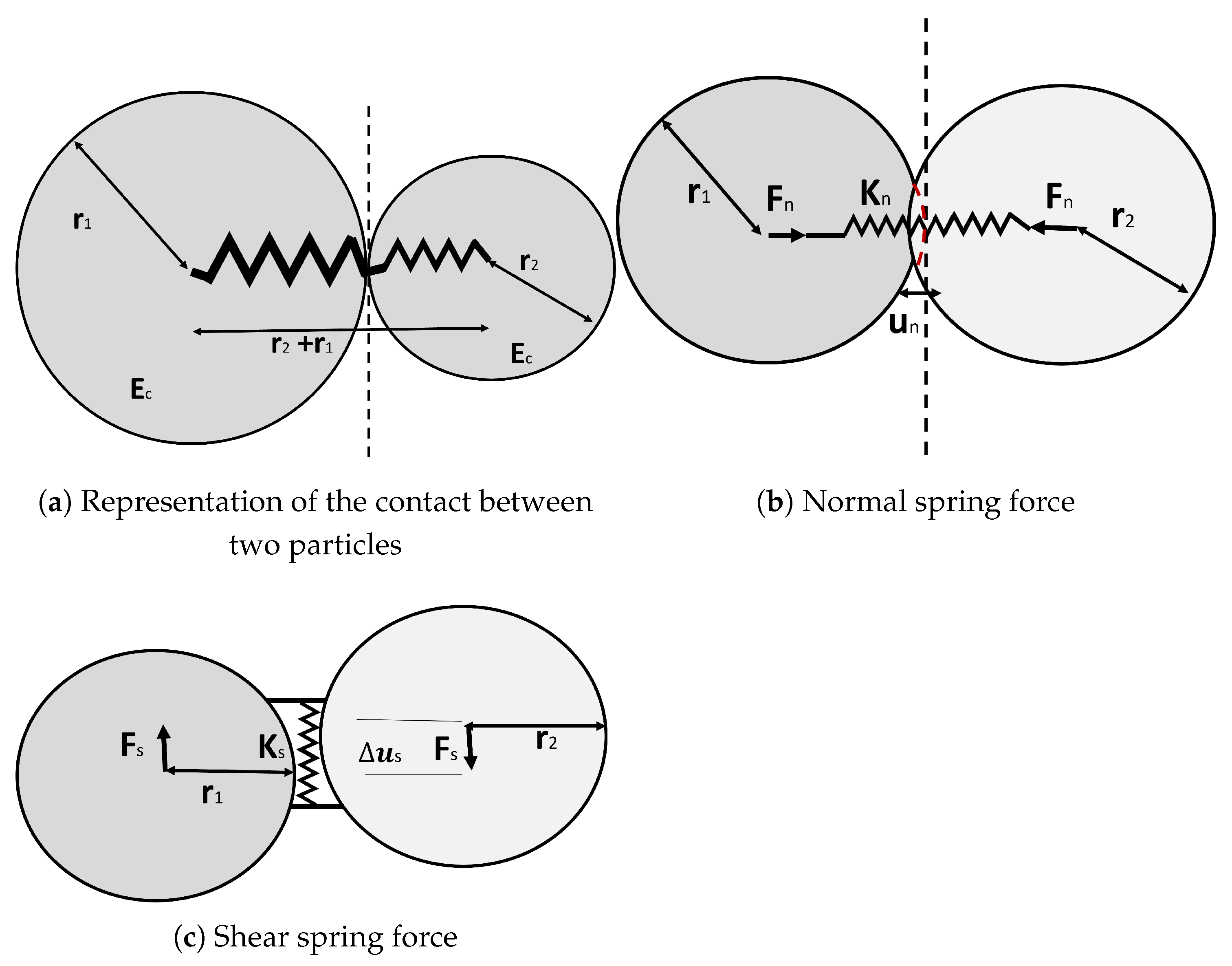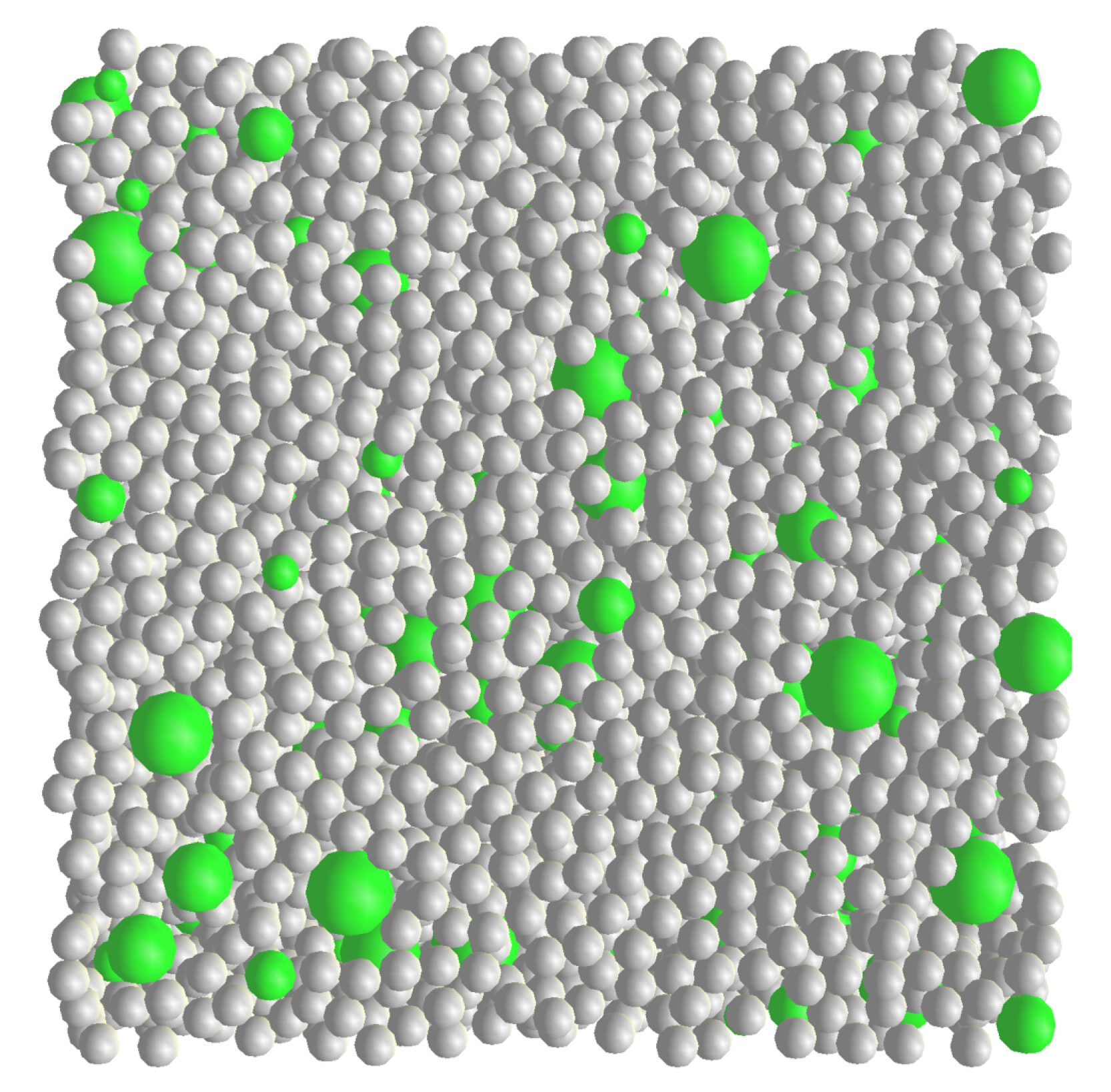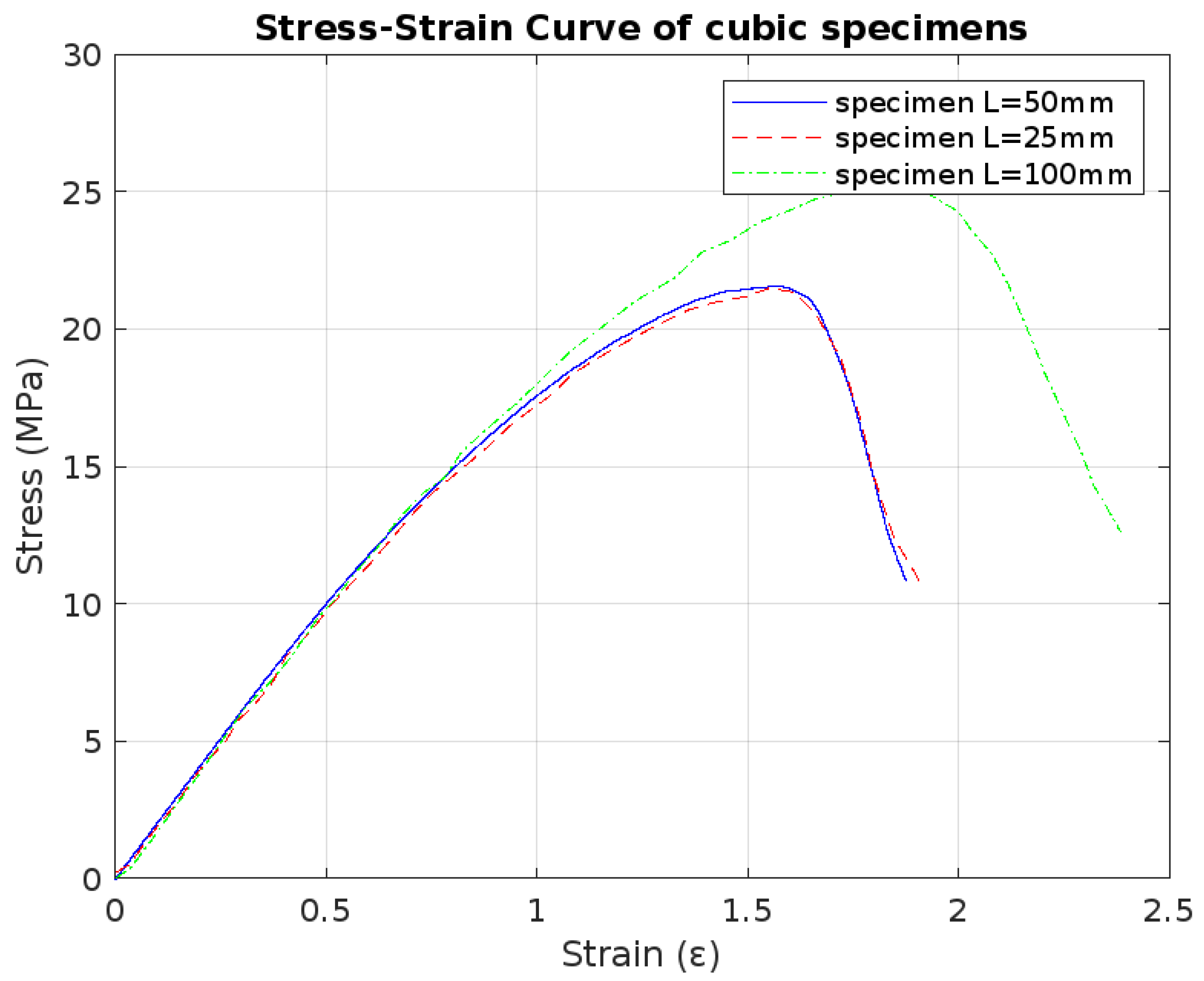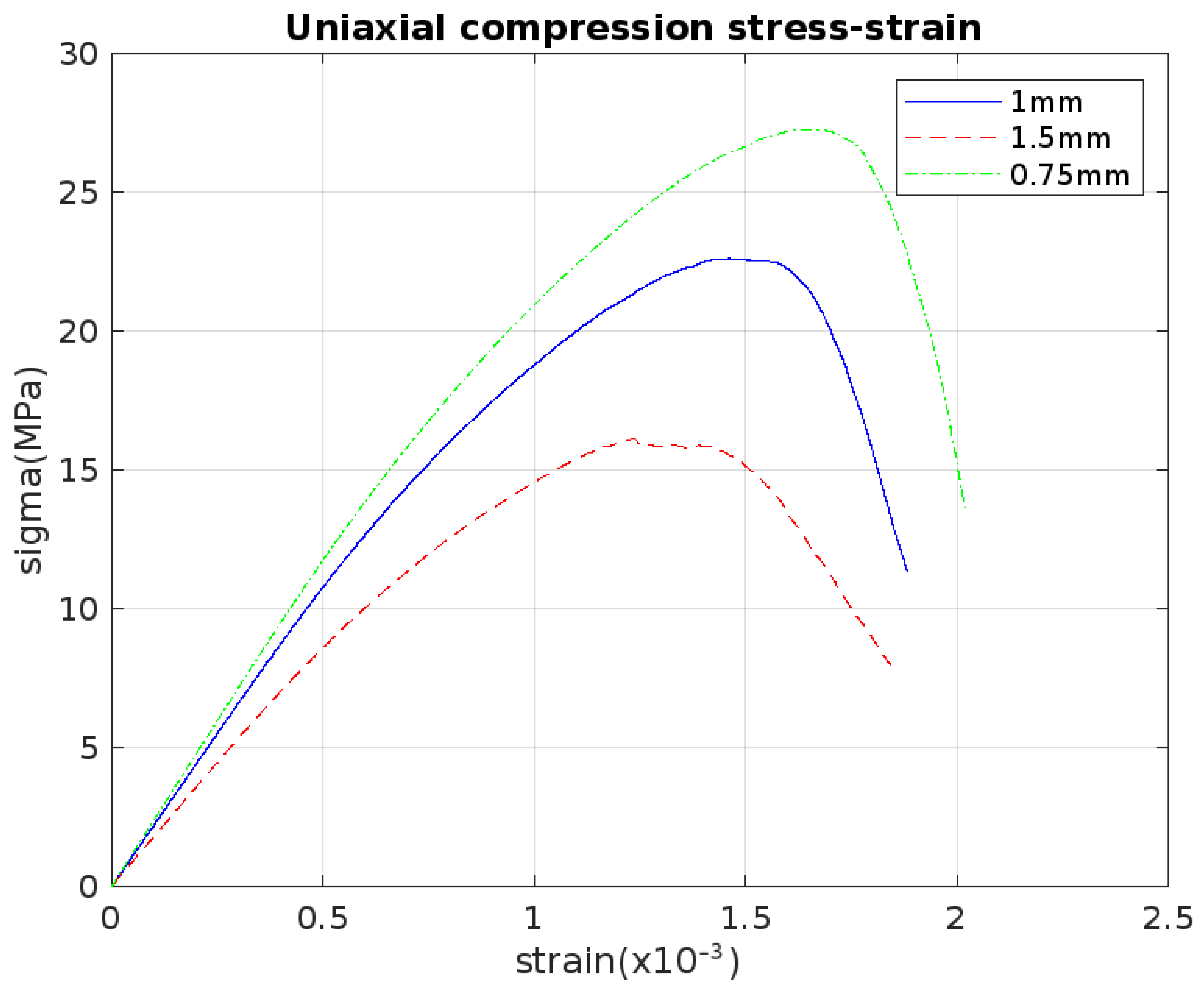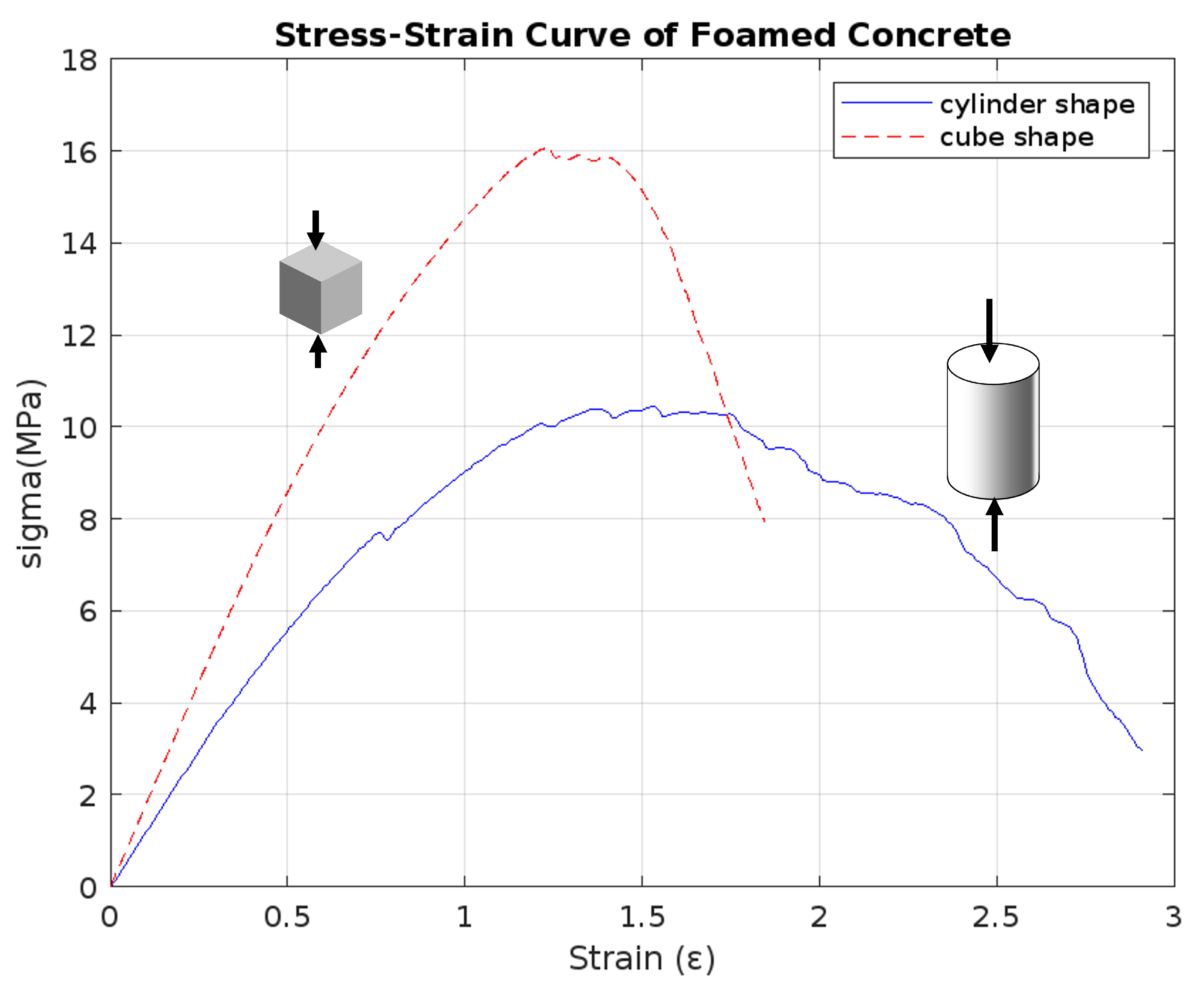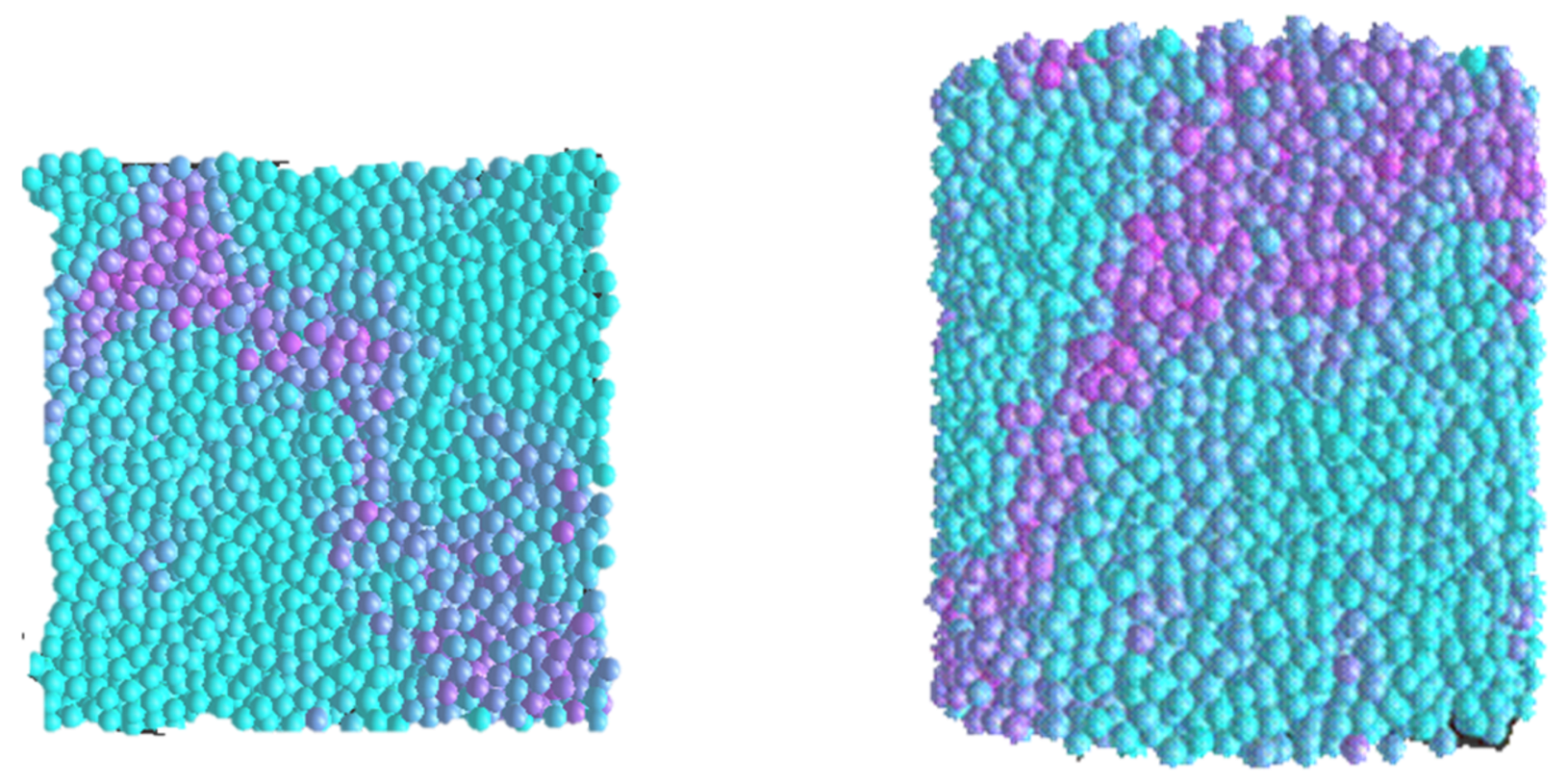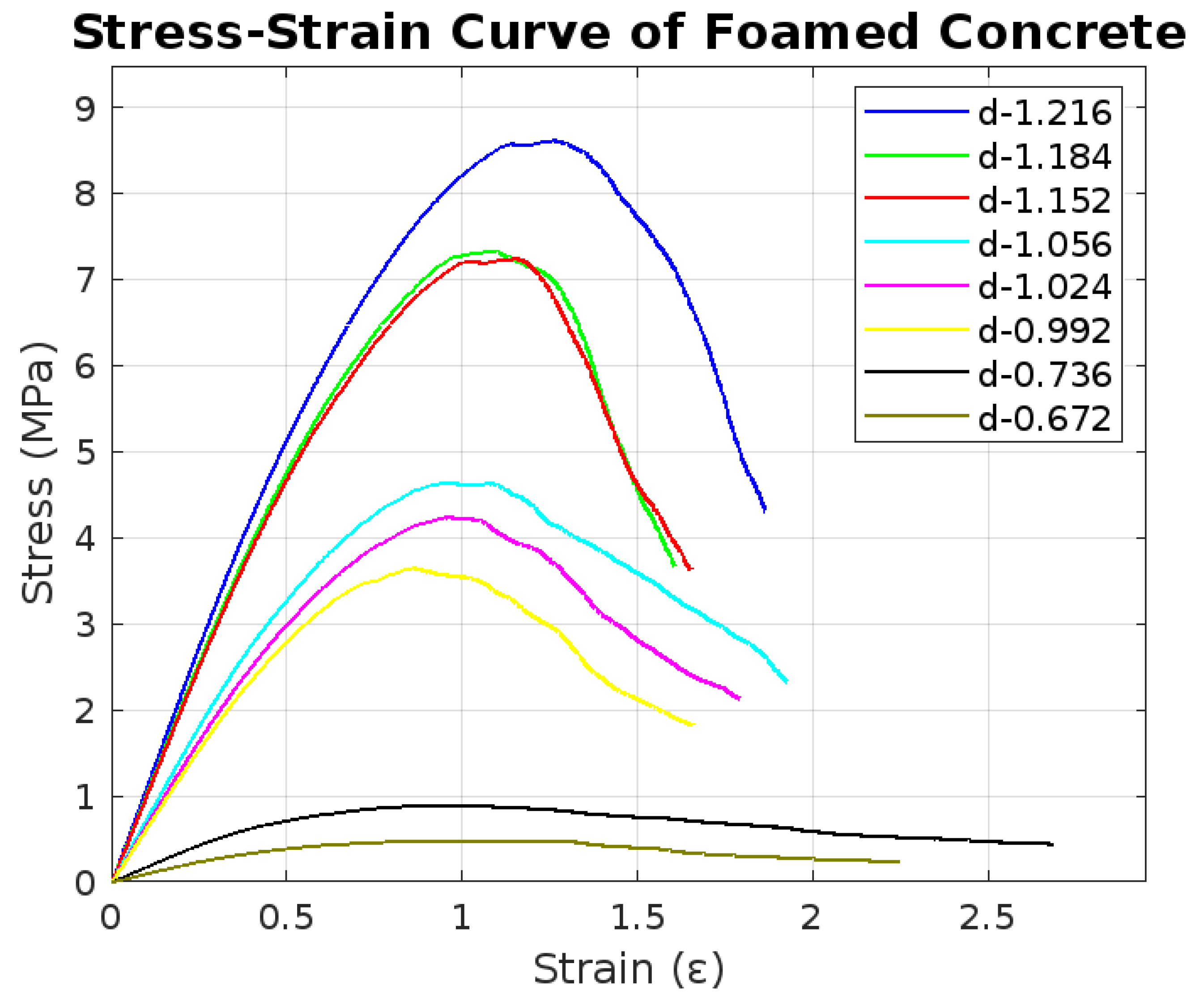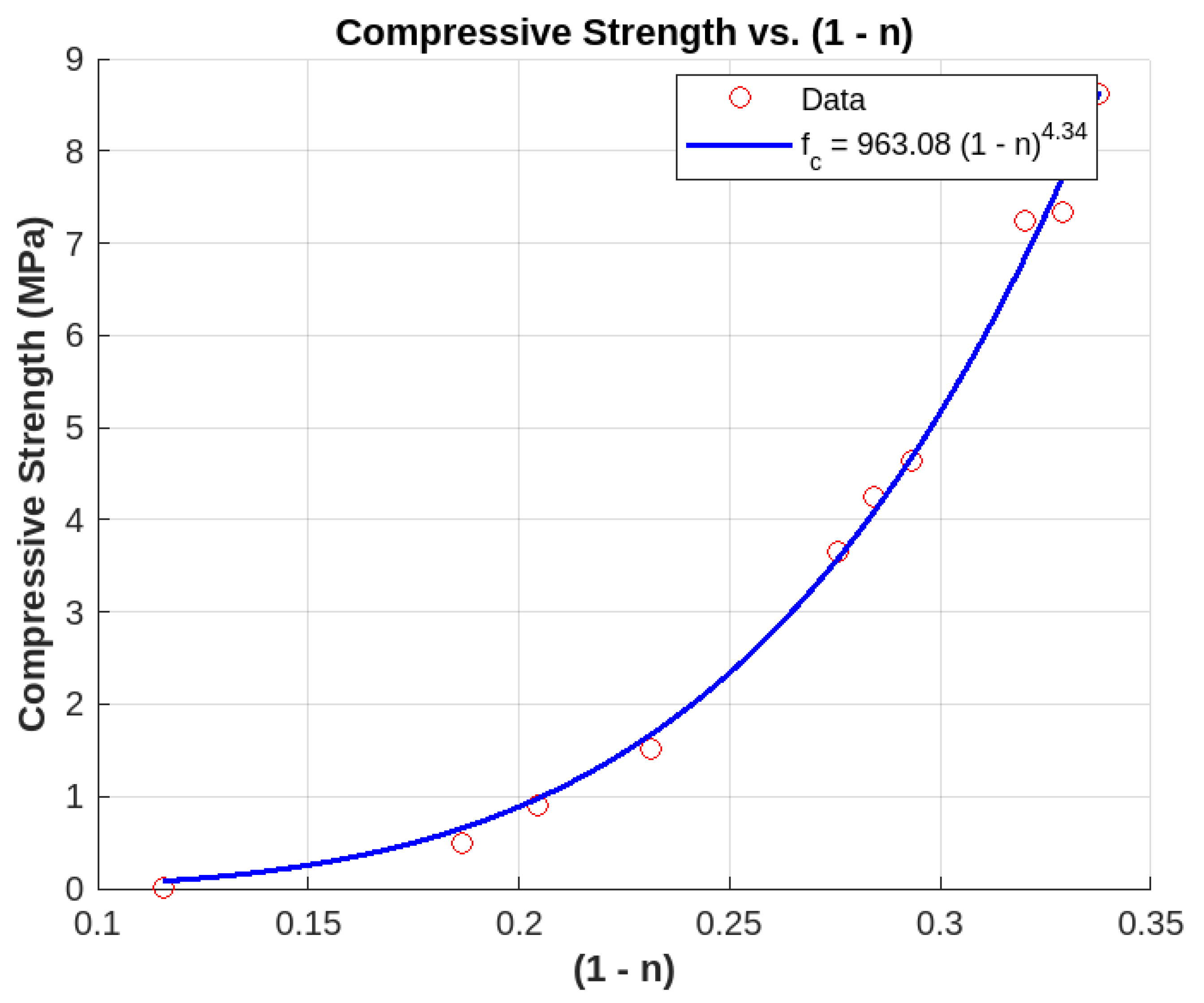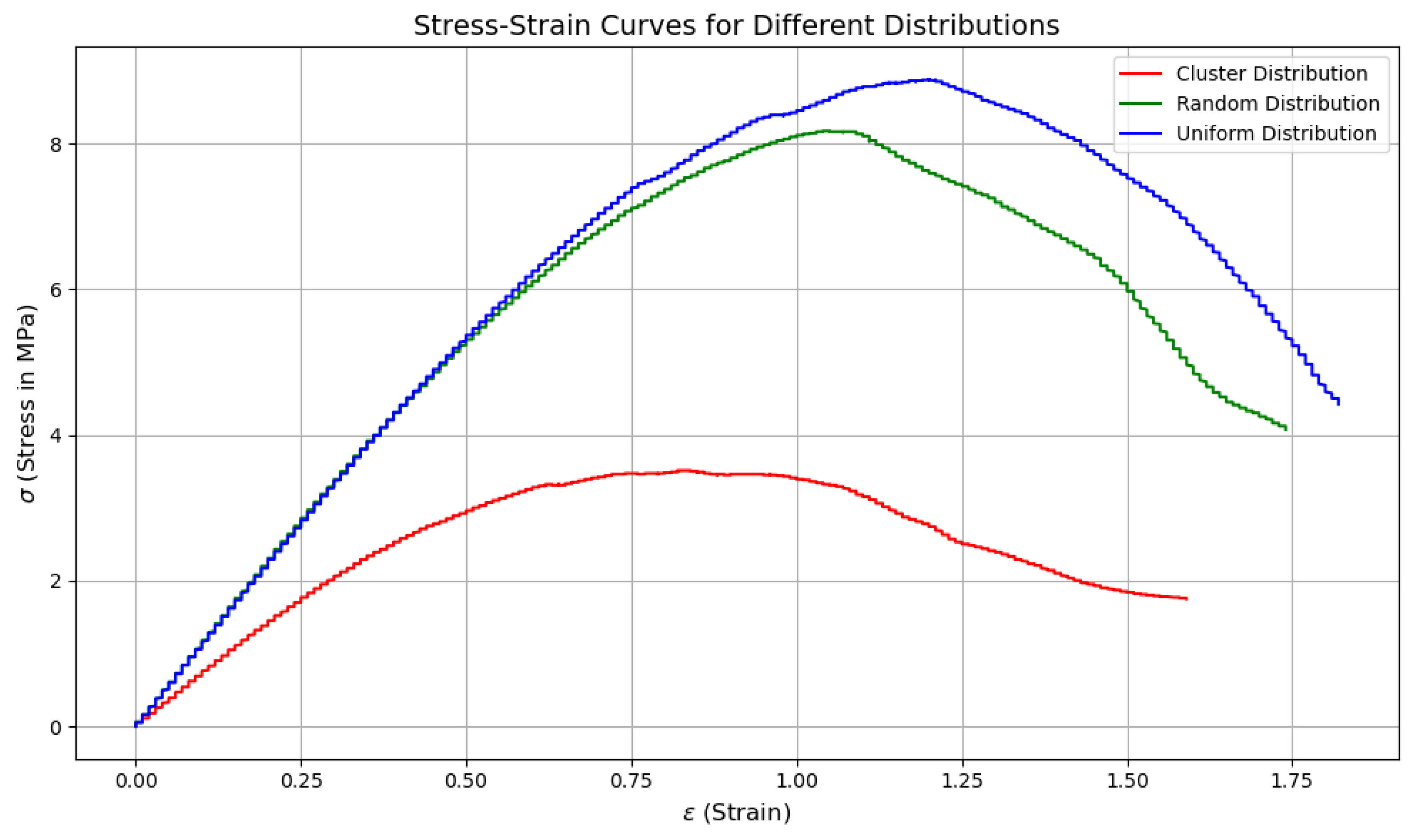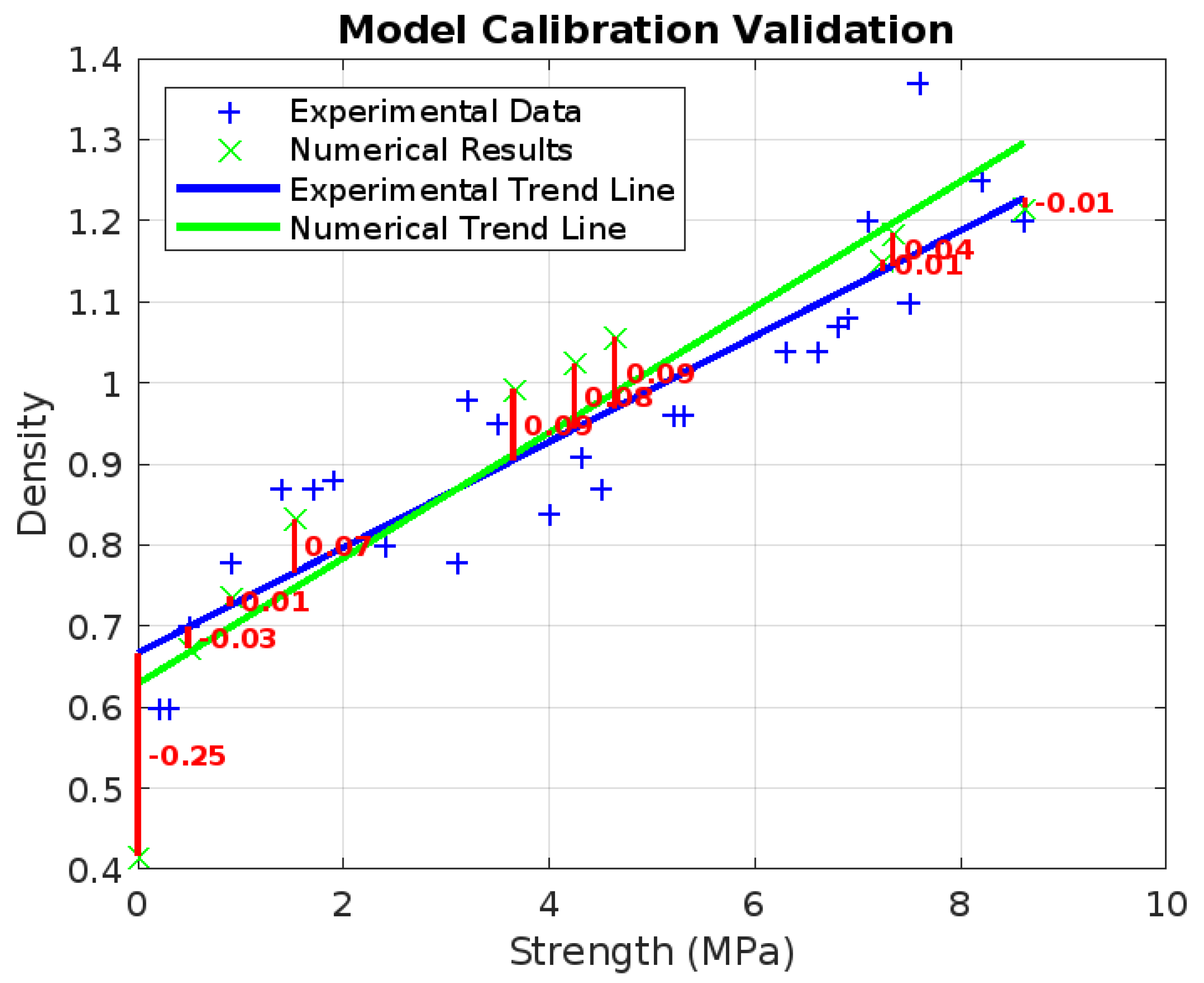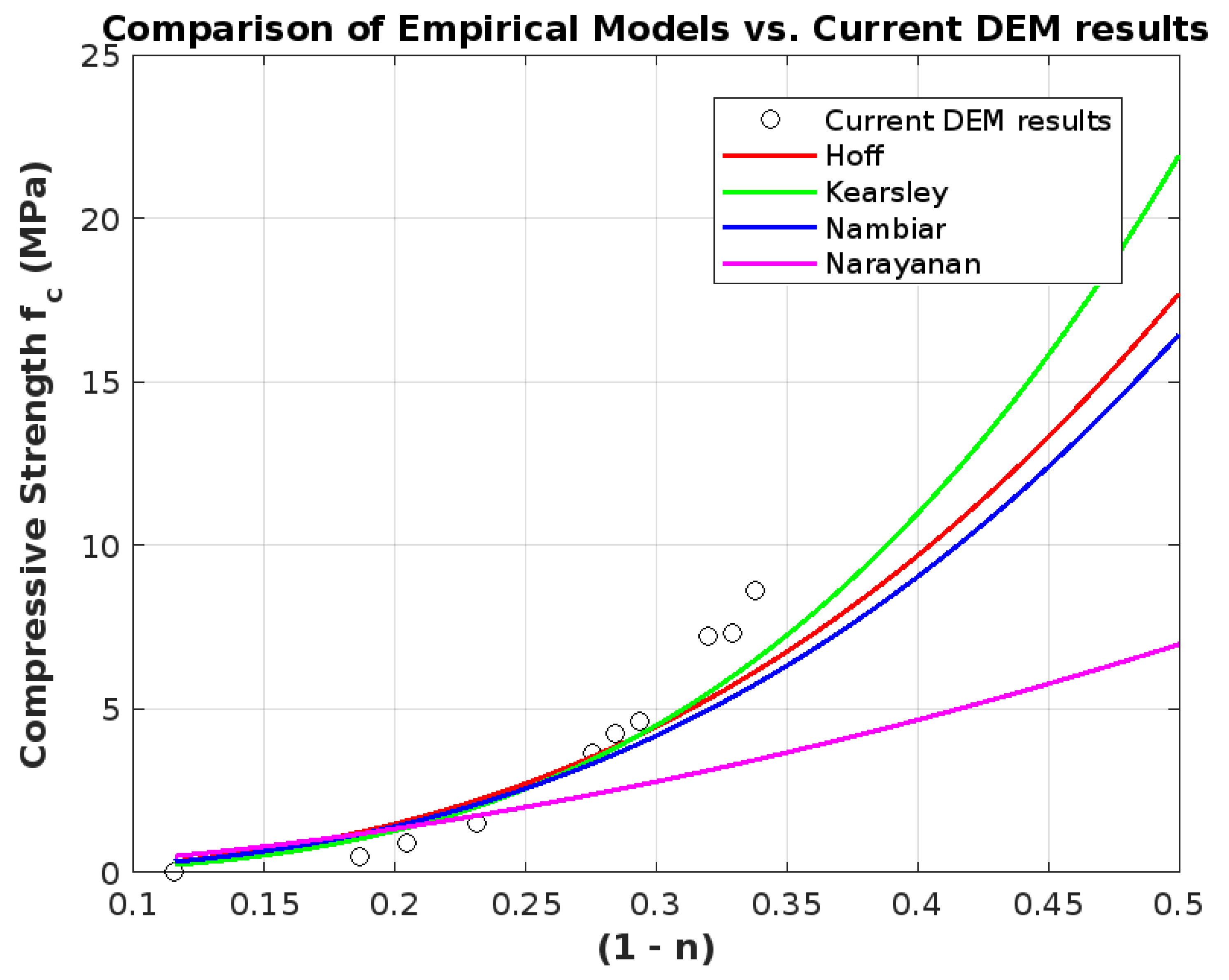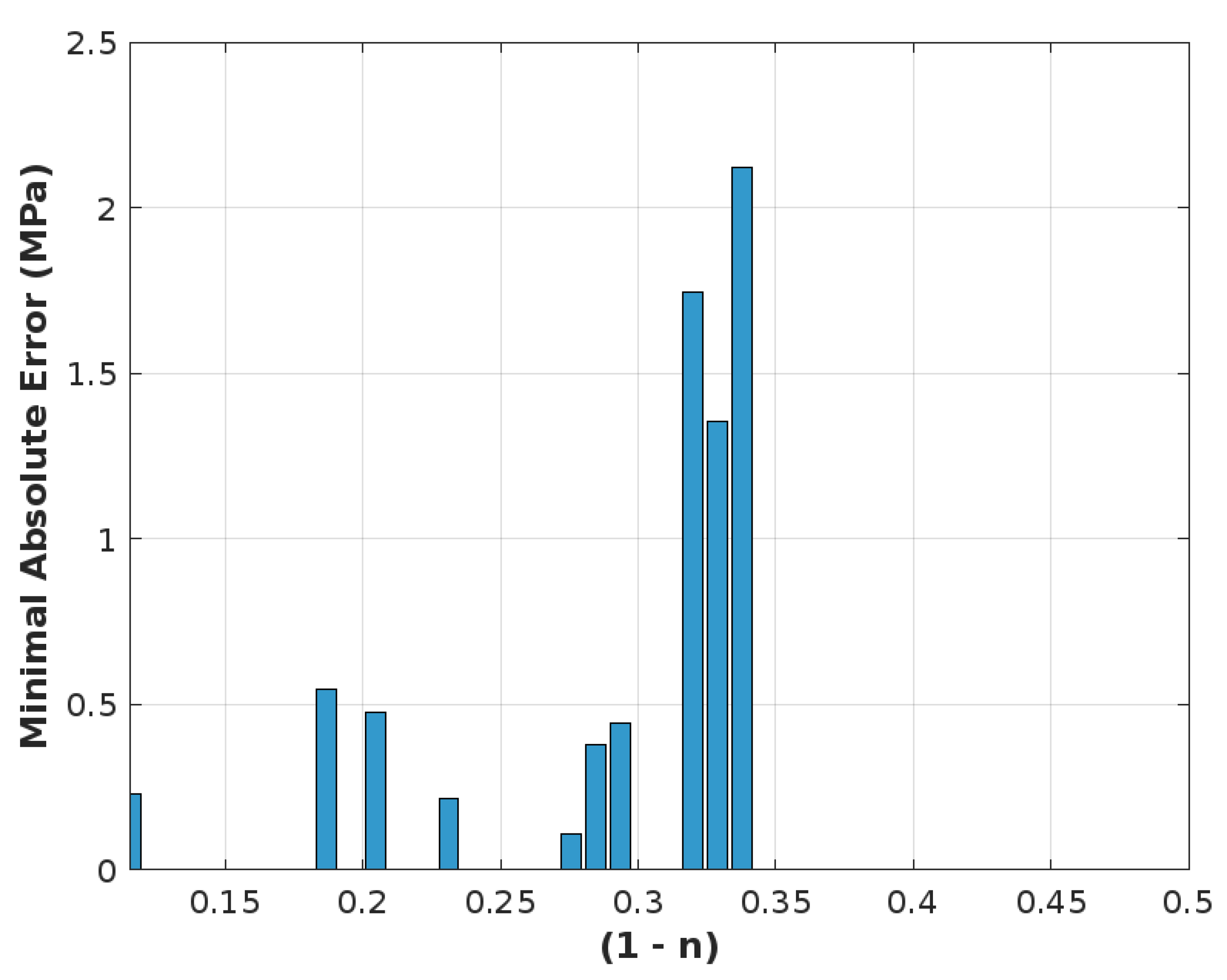1. Introduction
Foamed concrete, a lightweight building material made of cement, water, and a foaming agent, is becoming more and more popular because of its special advantages, which include a reduced density and improved thermal insulation [
1,
2]. The discrete element method (DEM), a numerical technique that models the response of materials at the particle level, is used in this work to investigate the mechanical behavior of cellular concrete [
3]. Cellular concrete is an innovative building material that provides a cost-effective and sustainable solution for many construction applications [
4,
5]. Foamed concrete is a durable material that can be used to build foundations, walls, roofs, and floors [
4].
This study uses (DEM) to investigate how particle size, porosity, and void distribution affect the strength of cellular concrete. The goal is to understand how these factors influence mechanical performance and improve material design. It is expected that larger particles create more voids, reducing strength, while higher porosity weakens the material by limiting load transfer. Additionally, the way voids are distributed plays a crucial role—uniformly spread voids improve strength, whereas clustered voids create weak spots that lead to failure. The simulations provide a detailed analysis of these effects under compression, helping to predict material behavior and optimize concrete properties.
The mechanical behavior of cellular concrete poses unique modeling challenges due to its heterogeneous structure of solid phases incorporated with air voids [
6,
7]. Numerous investigations have been conducted to experimentally understand the behavior of this material [
6,
7,
8,
9]. However, accurately characterizing its mechanical properties remains a challenge, particularly in capturing the complex interplay between embedded air spaces and the solid matrix [
10]. While various numerical methods have been employed to simulate the material’s behavior, significant gaps persist in effectively representing both its mechanical response and microstructural characteristics [
7,
9]. The finite element method (FEM) is widely used to predict the overall behavior of concrete structures by modeling them as a continuous field [
11]. However, FEM struggles to accurately capture the discrete and heterogeneous nature of concrete at smaller scales, where localized failures and microstructural effects play a crucial role. To address this limitation, the discrete element method (DEM) is employed to simulate concrete at the particle scale, representing the discrete interactions between material components [
3,
6]. DEM has been extensively used across various disciplines, including physics, materials science, geology, and engineering, to study the behavior of granular materials [
12]. Originally introduced by Cundall and Strack in 1979 for soil modeling [
3], DEM represents a system as an assembly of discrete particles that interact through physical forces such as friction, collision, and gravity. The core principle of DEM relies on a numerical algorithm based on Newton’s laws of motion and contact laws governing particle interactions. By simulating the motion of each individual particle, DEM enables the prediction of macroscopic system behavior, including flow characteristics, packing density, and stress distribution. This makes DEM particularly useful for capturing the micro-mechanical behavior of cellular concrete, where the interaction between voids and the solid matrix significantly influences the overall mechanical response. The discrete element method (DEM) has emerged as a powerful numerical tool for simulating cellular concrete and other quasi-brittle materials, providing insights into fracture mechanics, mechanical properties, and multi-scale behaviors. Recent studies have demonstrated the efficacy of DEM in modeling concrete strength and crack propagation, with validated 3D models capturing stress–strain responses and energy release during fracture processes [
13]. The interfacial transition zone (ITZ) has been identified as a critical factor influencing concrete mechanical properties, with DEM simulations revealing its dominant role over aggregate tensile strength [
14]. Studies on cellular concrete have examined its behavior under autoclaving treatment, improving the understanding of internal heat generation and phase transformations [
15]. The development of multi-scale DEM approaches, such as the discrete element-cell method (DECM), has allowed for a more comprehensive analysis of stress distributions in composite materials [
16], and simulations of recycled concrete have highlighted the significant influence of ITZ on fracture behavior [
17]. Thermal effects on DEM modeling have been examined in geothermal pavement bases, where temperature fluctuations influenced material stiffness and deformation [
18], and in rheological analyses, where viscoelastic contact models were found to significantly affect asphalt concrete behavior [
19]. Advanced applications of DEM have included tunnel concrete lining damage modeling under fire and explosion loads [
20], as well as fresh concrete flowability predictions in slump and J-Ring tests, demonstrating high accuracy in flow behavior simulations [
21]. While significant progress has been made in DEM modeling of cellular concrete, future research should focus on refining multi-scale simulations and enhancing experimental validations to further improve predictive accuracy and practical applications in engineering structures.
Conventional numerical techniques like the finite element method (FEM) have been used extensively for concrete modeling. Rezakhani et al. [
7], for instance, created a mesoscale FEM to model the alkali-silica reaction in concrete, effectively capturing the cracking and expansion properties. Similar to this, Wei et al. [
22] investigated the thermal characteristics of cellular concrete using the finite volume technique, concentrating on the heat transport mechanism. However, the particle interactions and distinct void distributions that significantly impact the mechanical response of cellular concrete are not captured by current continuum-based approaches, which are predicated on homogeneous material assumptions. A meso-equivalent element method was presented by Zhou et al. [
6] to simulate foamed concrete with spherical pores, offering information on how the material will react to loading at the millimeter scale. Despite offering a more sophisticated understanding, this method highlights the necessity for more detailed explicit modeling techniques for air void systems. The works by Hentz et al. [
23] and Oñate et al. [
24] have successfully demonstrated the capability of the discrete element method (DEM) in capturing fine-scale interactions and complex damage mechanisms in reinforced concrete. Although these studies primarily address reinforced concrete, their methodologies indicate the potential of DEM for detailed simulation of particle–particle interactions and localized degradation processes, making it particularly promising for modeling discontinuous and porous materials such as cellular concrete.
Despite these advancements, few studies have used DEM to accurately model the microstructure of cellular concrete, especially when it comes to portraying the distribution of air voids. This limitation is important because the porosity of cellular concrete, which is directly connected to the size, distribution, and connection of these air voids, has a substantial impact on the material’s compressive strength [
25]. Predicting the mechanical performance of cellular concrete requires an effective understanding of this connection.
There are many models that predict the compressive strength of cellular concrete in the literature. In [
25], a model based on the generalized model of Balshin has been studied and showed good results. The model is based on the following equation:
where
is the compressive strength,
n is the porosity, and
and
are two constants that depend on the formulation of cellular concrete.
Several mathematical models can be used to predict the compressive strength of foamed concrete. Kearsley and Wainwright [
26] have suggested a model that links the density and porosity of foamed concrete to its compressive strength. Their equation’s general form is:
where:
is the compressive strength (MPa),
A,
n, and
m are empirical constants,
P is the porosity, and
is the density (kg/m
3).
Narayanan and Ramamurthy [
27] have suggested a comparable relationship that accounts for the material’s density and porosity:
where:
is the compressive strength (MPa),
k,
a, and
b are constants,
is the density (kg/m
3), and
P is the porosity (fraction).
Furthermore, Hoff [
25] established a porosity-based relationship in which the porosity of cellular concrete has an inverse relationship with its compressive strength:
where:
is the compressive strength (MPa),
C and
n are constants determined empirically, and
P is the porosity (fraction).
Table 1 summarizes different equations in the literature for the values of these two constants.
Although these analytical models provide useful compressive strength predictions, they are limited by the fact that they do not take into consideration the intricate microstructure of cellular concrete or the interactions between particles and voids. Conversely, the discrete element method (DEM) can model particle-level interactions and void distribution, yielding a more precise compressive strength prediction [
3].
The distribution of voids has a significant impact on how cellular concrete behaves mechanically. Uniform distributions and other homogeneous void designs have been demonstrated to enhance stress distribution and slow the spread of cracks by reducing localized stress concentrations [
29]. Clustered voids, on the other hand, create weak spots in the material that cause it to collapse too soon under loading circumstances [
29]. Nguyen et al. [
10] investigated the impact of voids on the compressive behavior of foamed concrete through both computational and experimental methods. Their results demonstrated that while void clustering considerably weakens the material, uniform void distributions improve load transmission efficiency. Likewise, non-uniform void placement negatively impacts mechanical strength, especially at greater porosity levels, as shown by Narayanan and Ramamurthy [
27].
To correctly predict the behavior of cellular concrete, numerical models must be calibrated. In order to match numerical results with experimental data, the Discrete Element Method (DEM) necessitates meticulous calibration of factors including particle size, contact stiffness, and porosity [
30]. To produce precise compressive strength predictions. In [
10], Nguyen et al. verified their numerical model and found a high correlation between experimental values and simulation results. Density and void distribution were the main criteria used in their calibration process to develop the model.
Our work attempts to close the gaps in the application of DEM to cellular concrete, specifically in the creation of realistic air void models. These contributions have the potential to advance knowledge and use of cellular concrete in structural and sustainable engineering contexts, laying the groundwork for more environmentally friendly and effective building materials.
This paper presents a DEM simulation of the compressive strength test of cellular concrete on the YADE platform [
31]. The specimen is modeled by the interaction of a uniform distribution of spheres. The sample contains two phases: the air-void system and the solid skeleton. First, the contact model of the solid skeleton is presented in detail. Then, the numerical specimen is generated. Lastly, a series of uniaxial compressions was performed to investigate the response of cellular concrete.

